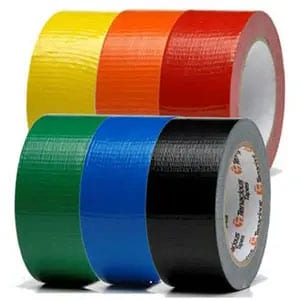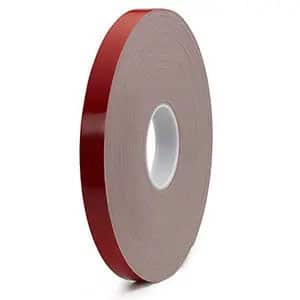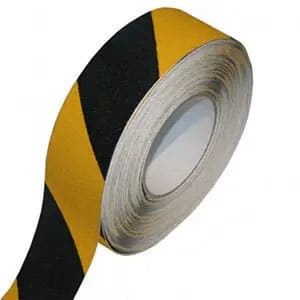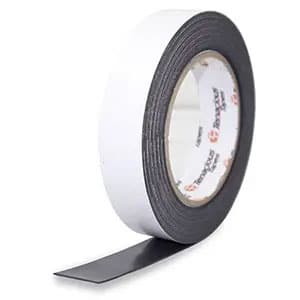FAQ
What is Pressure Sensitive Tape?
This is the technical term for any type of “adhesive tape” or “sticky tape”. It means that the adhesive, at room temperature, is aggressive and permanently tacky and will adhere to a wide variety of surfaces without the need for more than finger or hand pressure. Tapes can either have adhesive coated one side of a carrier (single sided tapes) or on both sides (double sided tapes). The vast majority of adhesive tapes sold fall under this category, although there are also tapes that are dry or non-tacky to the touch at room temperature and require an activator to get them to bond such as heat, water or some other solvent.
It is important to understand that the pressure required to form a bond with a surface will depend on a number of different parameters (type of adhesive, nature and smoothness of the surfaces and the ambient temperature, being the main factors). It is always important to use firm pressure when applying tape, since the ultimate bond strength is dependent on the degree of contact between the adhesive and the surface it is being bonded to. A common reason for tape failure is due to poor initial contact between the adhesive and the bonding surface.
How do I get the best result from a Pressure Sensitive Tape?
Whenever you are considering using a tape there are three areas that need to be considered and understood:
- What do I want the tape to do – precisely?
- What product is most likely to cost effectively meet my application requirements?
- What issues need to be considered when applying the tape to get the best results?
Whilst we are in the business of providing tape to solve people’s application problems, we recognise that tape may not always be the best solution and are happy to advise when we feel that some other solution may be more appropriate e.g. liquid glue or mechanical fastener.
What factors do I need to consider when selecting a tape for an application?
Factors that need to be considered when selecting a tape
When selecting a tape for any application it is important to consider precisely what your expectations are over and beyond the tape simply fulfilling its function. For example, if you were using a tape to seal a gap, here are some issues you may need to consider:
- Appearance and/or aesthetics
- Nature of the surface/surfaces the tape is to be stuck to, how smooth they are and also what they are made of (high or low energy surfaces)
- How long do I want the bond to last (longevity)
- Does the tape need to clean remove (bond temporary or permanent)
- Does the tape need to withstand temperature, humidity, UV and, if so, how much and for how long
- Any other peculiar local conditions of the application e.g. presence of chemicals in the environment or surfaces to which tape is to be stuck that could affect its performance (e.g. presence of plasticizers)
- Will bond be subjected to stresses, if so, what type and for how long (e.g. shear, peel, tensile or shock loads and, if a double sided, are the two surfaces prone to differential expansion and contraction
- Clarity
- Does tape need to be hand-tearable
- Flame retardancy
- Relative importance of price versus performance
What product is most likely to cost effectively meet my application requirements?
This is the area where you may need the help of somebody with specialist knowledge of tapes and, in order that they can offer the best advice, they will need to know as much about your application as possible. Whilst we can recommend products we can never “guarantee” them, since there are just too many variables that can affect the performance of a tape. That is why we are happy to provide samples and specifications to allow you to carry out tests to ensure that any product meets your application requirements. Inevitably cost may be a consideration and only the user can determine what product is “acceptable”.
What issues do I need to consider when applying the tape to get the best results?
For any given use of a particular tape to a particular surface there are only three factors that can affect the performance of the bond:
- The pressure applied to the surface to form the bond
- The ambient temperature and environmental conditions when the tape is applied
- The cleanliness of the surface to which the tape is being applied
When testing tapes for a new application it is vital to ensure that these three issues are addressed. Therefore, if the bond fails, one can determine with a degree of confidence that one has selected an inappropriate product. Should one encounter a problem with an application where a product has performed satisfactorily in the past, it is normal to immediately assume that the tape is at fault. Whilst this may be possible, in the vast majority of cases it is down to one or a mixture of the following factors:
-
Pressure
The required pressure to form a satisfactory bond will depend on the softness of the adhesive, its coat weight (mass of adhesive) and the smoothness of the surface. Thus, adhering a double sided cloth with a high coat weight to a smooth surface is going to require much less pressure to wet-out than a thin, pure acrylic filmic tape on a textured surface.
Tenacious Tapes sell hand pressure rollers (XL100 100mm & XL50 50mm) to assist in the application of tape and these are very useful tools in ensuring that the adhesive wets-out onto the underlying substrate. The importance of getting the adhesive in firm contact with the bonding surface cannot be over-stated. Since, not only are you losing the full benefit of the adhesive, but you are also creating the opportunity for air and moisture to get in underneath the tape and, through both oxidization and capillary action, you will see a far quicker breakdown in the effectiveness of the bond.
-
Temperature & Ambient Conditions
All pressure sensitive adhesives are susceptible to temperature. As the temperature rises, so an adhesive will soften and thus they flow and wet-out more easily on a surface. Most manufacturers recommend that the temperature, at time of application, is above 15° C. Consequently one can regularly encounter problems with pressure sensitive tapes during the cooler, winter months. This phenomenon is very easily demonstrated by putting a roll of tape in a refrigerator overnight and then testing it the following morning. You will notice that the adhesive is very “dead” to the touch but warm it up and observe the difference. In large factories, open warehouses or construction sites, where it is not practical to warm the local environment, it may be necessary to keep rolls warm by a heater or some other place until actually being used. Though ideally, both the tape AND the bonding surface should be warm.
Apart from temperature, moisture can also affect the quality of the bond. This can either be at times of very high relative humidity where the atmosphere is close to saturation or close to the dew point on cold mornings. Metal surfaces are particularly susceptible to moisture condensing on them and thus bond strengths being compromised.
-
Surface Preparation
It is vital that surfaces are presented for bonding clean, dry and free from any surface contaminants. Surface contaminants can include dust, dirt, grease, rust or other oxidants, mould release agents from plastics, residual detergents, oil from skin and loose particles from unsealed surfaces. All such foreign bodies have the effect of deadening the adhesive and degrading the bond strength that can be achieved.
Tenacious Tapes stock Surface Cleaning Wipes that contain Isopropanol and these are ideal for sample testing or for inclusion in kits and may be used for minor soiling. Where surfaces are more highly contaminated we recommend the use of our X400 Solvent Cleaner (1 Litre tin) or X440 Solvent Spray (350g canister). These solvents should be used in conjunction with a lint free rag and safety precautions for use followed. When cleaning a surface ensure that you only wipe in one direction, to prevent cross-contamination and ensure that the surfaces are completely dry before applying the tape. It is also important to avoid touching or handling the adhesive as the oil on one’s skin will deaden the adhesive’s tack.
Structural Bonding
When using products such as the Foamed Acrylics for structural bonding applications then particular care needs to be taken with surface preparation since contaminated surfaces can seriously degrade the quality of bond that can be achieved. It is strongly recommended to only use Isopropanol or a specifically recommended surface cleaner as part of this process. A three stage process may be required:
- Clean the surfaces with a solvent and lint free cloth
- Lightly abrade the entire keying surface using a scouring pad (e.g. Tenacious X990), this will assist in removing any surface oxides or mould release agents and also provide increased keying surface for the adhesive.
- Final clean using the solvent to remove any loose particles.
Note: The following, commonly used solvents, are not recommended for cleaning surfaces as they do not necessarily evaporate cleanly and can leave a surface film that may impair bonding: petrol, methylated spirits, turpentine, kerosene, prepsol, citrus cleaners and window cleaners.
On certain low energy surfaces it may be necessary to consider using some type of primer to make the surface receptive to a pressure sensitive tape. A primer acts as a link between the substrate and the tape by increasing the number and type of adhesive forces at the surface interface. Whilst not normally necessary, the use of primers on surfaces may be required should one need the attributes of a product with high cohesive strength on a low energy surface. The use of primers may represent significant health and safety issues in their use within the workplace. It is recommended that you seek technical support from your supplier should you find that the product selected does not meet your application requirement or expectations. Tenacious Tapes can assist with primers for a range of surfaces. N.B. Careful surface preparation can often negate the need for primers.
Why do I need to test the tape?
Since every application is subtly different it is impossible for the tape distributor to “guarantee” a product for an application. In determining whether you need to conduct tests you need to consider such things as:
- The direct consequences of the tape failing
- The consequential costs in terms of time, money and damaged reputation to rectify the situation should the tape fail
- Has the product been used successfully for similar applications before
In situations where time prevents the luxury of conducting tests it is important that one fully assesses the likely suitability for the application and then addresses all the issues that could compromise the performance of the tape. However we gladly provide samples and specifications for customers to test and evaluate products without obligation, since it is only the user of the tape that can truly assess a product’s suitability for their intended application.
Whilst Tenacious Tapes can guarantee that a product supplied will perform in accordance with its published performance characteristics, we cannot “guarantee” a customer’s application. It will always remain the responsibility of the customer to assess its suitability for their intended application and accept any liability should it not prove suitable.
The tape has failed, what should I do?
The natural presumption when a tape fails in an application is that the tape must be faulty, whilst this may be the case, this is normally the least likely answer. The most likely reasons for tape failure in order of probability are:
For an existing application (tape has been used successfully before for some time)
- Insufficient pressure was applied
- The ambient conditions were inappropriate, normally this means either too cool (the majority of tapes need to be applied, ideally, between 15° & 25° C) or there was too much moisture in the atmosphere (close to Dew Point or very high relative humidity)
- The surfaces were not clean or have become contaminated with something that compromises the bond strength
- The surface has actually changed (the manufacturer may be using a different process/ingredient in their product that renders the tape unsuitable/incompatible)
- The tape is not up to specification in some respect e.g. low coat weight of adhesive
Invariably one will find that the answer is a mixture of all or some of these factors and so careful analysis of the failure is required to identify the likely cause and then be in a position to remedy it. See guidance under How do I get the best result from a Pressure Sensitive Tape?
New Application
- The tape used is not appropriate for the application it is being used for
- As for existing applications (above)
Once you have analysed the reason for failure, contact Tenacious Tapes or the distributor that supplied the tape, to discuss the best way to resolve the issue.
Please note that, whilst we have full product liability insurance to cover the consequences of defective tape being supplied, where failure is due to some other reason, the cost of resolution is at the user’s expense. This is why it is very important that tapes are adequately tested prior to use for any critical application.
How do I remove adhesive residue from a surface?
Many of the uses for pressure sensitive tapes are of a temporary nature and often it is important that the tapes remove cleanly without leaving any residue. If clean removal is a critical criteria for the tape’s use then careful initial selection is required. However, removal of adhesive residue is a common issue. Tenacious Tapes have developed the X400 Surface Cleaner (1 Litre tin) or the X440 Spray Cleaner (350g canister) to clean surfaces prior to the application of tape. However these same products can be used to remove adhesive residue from surfaces where the adhesive has not hardened (oxidized). If the adhesive has oxidized then solvents will not tend to work and some form of abrasive material may be required (e.g. X990 Scouring Pads).
A common problem is the mess left when a double sided foam tape is removed. In this instance, since the bond of the tape is greater than the internal strength of the foam, it is very common to see foam left on both surfaces. Most foams are inert to the solvents and therefore it is necessary to mechanically scrape away any foam and then use a solvent on the residual adhesive. Obviously this process is very time consuming and is quite likely to result in the damage of surfaces. For any application where clean removal is an important parameter, speak with us or your local distributor as we have a wide range of products, including foams, that are designed to clean-remove.
However, if a large scale clean-up is involved, then a 50:50 blend of Toluene and Methyl Ethyl Ketone (MEK) is recommended. Normally Toluene works best for rubber based adhesives and MEK or Acetone for acrylics. N.B. These solvents are very aggressive and so they need to be carefully tested, particularly on plastics, for compatibility.
When using any solvents to remove adhesive residue ensure that manufacturer’s health and safety advice is observed.




